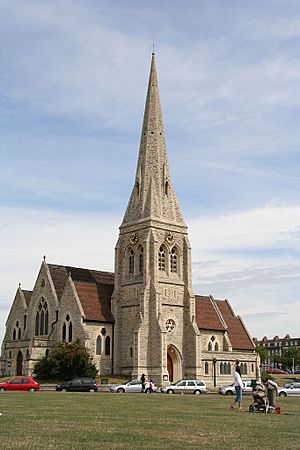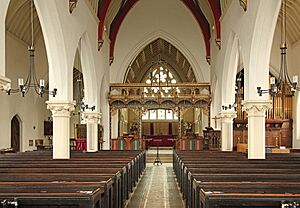All Saints' Blackheath facts for kids
Quick facts for kids All Saints' Blackheath |
|
|---|---|

All Saints' Blackheath
|
|
| Location | London, SE3 |
| Country | England |
| Denomination | Church of England |
| Website | https://www.allsaintsblackheath.org/ |
| History | |
| Founded | 1857 |
| Dedicated | 1858 |
| Architecture | |
| Heritage designation | Grade II |
| Architect(s) | Benjamin Ferrey |
| Years built | 1867 (present) |
| Administration | |
| Diocese | Southwark |
All Saints' Blackheath is a historic Church of England church located in Blackheath, London. It is a special building known as a Grade II listed building, which means it is protected because of its historical importance. The church first opened in 1858 and was designed by the architect Benjamin Ferrey.
Contents
The Story of All Saints' Church
Long ago, the area of Blackheath did not have its own church. People had to travel to nearby towns like Greenwich or Lewisham to worship. In 1854, the local community decided they needed their own church.
A kind nobleman, William Legge, 5th Earl of Dartmouth, donated the land for the new building. He laid the first stone to start the construction in October 1857. A year later, on November 1, 1858, the church was officially opened, or consecrated, by the Bishop of London. Even though it was open, building work continued until 1867.
Famous People and Events
The church has a rich musical history. Famous composers like Sir Arthur Sullivan and Gustav Holst led choirs here. From 1862 to 1866, the church's organist was Alfred Cellier, who also composed operas.
In April 1920, a special memorial screen was put up inside the church. It honors the local people who died in World War I.
A well-known humanitarian named Terry Waite once worked at All Saints' Church. He was held hostage in Lebanon from 1987 to 1991. For the entire five years he was gone, the church's vicar, Reverend Henry Burgin, kept a candle burning to show hope for his safe return.
Church Architecture and Design
The architect Benjamin Ferrey designed All Saints' to be a grand stone church. It was built using a special local stone called Kentish ragstone. One of its most noticeable features is the tall spire on its south-west corner.
Over the years, more parts were added to the church. In 1890, rooms called vestries were built. In 1899, a new porch was added. Both of these additions were designed by another architect, Arthur Blomfield.
The famous architectural critic Nikolaus Pevsner wrote about the church. He said it was special because it sits right in the middle of the grassy heath, looking like a perfect model.
Buildings Connected to the Church
The church has been involved with local education for a long time. In 1867, the parish took over a school that was first started in 1825. This school later became All Saints' C of E Primary School.
In the 1920s, the church needed a hall for community events. The 6th Earl of Dartmouth donated more land. A local architect named Charles Canning Winmill designed the All Saints' Parish Hall, which opened in 1928.


